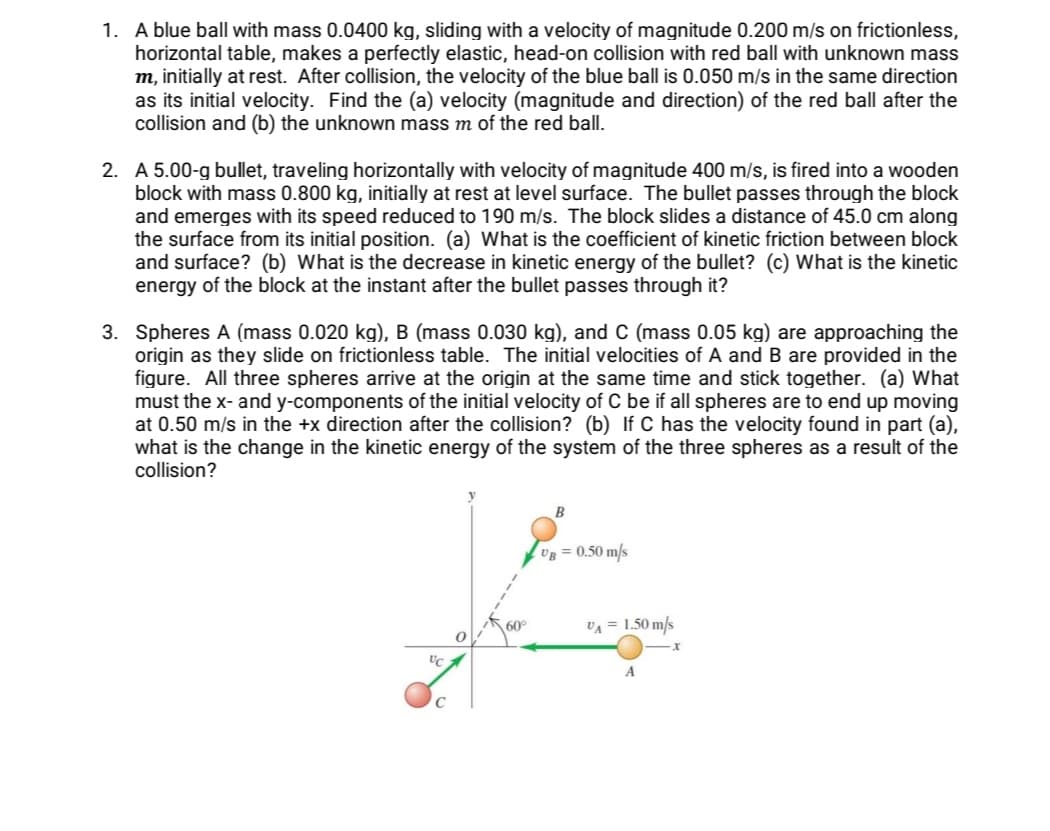1. A blue ball with mass 0.0400 kg, sliding with a velocity of magnitude 0.200 m/s on frictionless, horizontal table, makes a perfectly elastic, head-on collision with red ball with unknown mass m, initially at rest. After collision, the velocity of the blue ball is 0.050 m/s in the same direction as its initial velocity. Find the (a) velocity (magnitude and direction) of the red ball after the collision and (b) the unknown mass m of the red ball.
1. A blue ball with mass 0.0400 kg, sliding with a velocity of magnitude 0.200 m/s on frictionless, horizontal table, makes a perfectly elastic, head-on collision with red ball with unknown mass m, initially at rest. After collision, the velocity of the blue ball is 0.050 m/s in the same direction as its initial velocity. Find the (a) velocity (magnitude and direction) of the red ball after the collision and (b) the unknown mass m of the red ball.
Physics for Scientists and Engineers, Technology Update (No access codes included)
9th Edition
ISBN:9781305116399
Author:Raymond A. Serway, John W. Jewett
Publisher:Raymond A. Serway, John W. Jewett
Chapter9: Linear Momentum And Collisions
Section: Chapter Questions
Problem 9.91AP: A 2.00-g particle moving at 8.00 m/s makes a perfectly elastic head-on collision with a resting...
Related questions
Question
SOLVE THE 3 PROBLEMS BELOW

Transcribed Image Text:1. A blue ball with mass 0.0400 kg, sliding with a velocity of magnitude 0.200 m/s on frictionless,
horizontal table, makes a perfectly elastic, head-on collision with red ball with unknown mass
m, initially at rest. After collision, the velocity of the blue ball is 0.050 m/s in the same direction
as its initial velocity. Find the (a) velocity (magnitude and direction) of the red ball after the
collision and (b) the unknown mass m of the red ball.
2. A 5.00-g bullet, traveling horizontally with velocity of magnitude 400 m/s, is fired into a wooden
block with mass 0.800 kg, initially at rest at level surface. The bullet passes through the block
and emerges with its speed reduced to 190 m/s. The block slides a distance of 45.0 cm along
the surface from its initial position. (a) What is the coefficient of kinetic friction between block
and surface? (b) What is the decrease in kinetic energy of the bullet? (c) What is the kinetic
energy of the block at the instant after the bullet passes through it?
3. Spheres A (mass 0.020 kg), B (mass 0.030 kg), and C (mass 0.05 kg) are approaching the
origin as they slide on frictionless table. The initial velocities of A and B are provided in the
figure. All three spheres arrive at the origin at the same time and stick together. (a) What
must the x- and y-components of the initial velocity of C be if all spheres are to end up moving
at 0.50 m/s in the +x direction after the collision? (b) If C has the velocity found in part (a),
what is the change in the kinetic energy of the system of the three spheres as a result of the
collision?
B
Ug = 0.50 m/s
60°
VA = 1.50 m/s
A
Expert Solution
This question has been solved!
Explore an expertly crafted, step-by-step solution for a thorough understanding of key concepts.
This is a popular solution!
Trending now
This is a popular solution!
Step by step
Solved in 3 steps with 2 images

Knowledge Booster
Learn more about
Need a deep-dive on the concept behind this application? Look no further. Learn more about this topic, physics and related others by exploring similar questions and additional content below.Recommended textbooks for you

Physics for Scientists and Engineers, Technology …
Physics
ISBN:
9781305116399
Author:
Raymond A. Serway, John W. Jewett
Publisher:
Cengage Learning

College Physics
Physics
ISBN:
9781285737027
Author:
Raymond A. Serway, Chris Vuille
Publisher:
Cengage Learning

Physics for Scientists and Engineers with Modern …
Physics
ISBN:
9781337553292
Author:
Raymond A. Serway, John W. Jewett
Publisher:
Cengage Learning

Physics for Scientists and Engineers, Technology …
Physics
ISBN:
9781305116399
Author:
Raymond A. Serway, John W. Jewett
Publisher:
Cengage Learning

College Physics
Physics
ISBN:
9781285737027
Author:
Raymond A. Serway, Chris Vuille
Publisher:
Cengage Learning

Physics for Scientists and Engineers with Modern …
Physics
ISBN:
9781337553292
Author:
Raymond A. Serway, John W. Jewett
Publisher:
Cengage Learning

Physics for Scientists and Engineers
Physics
ISBN:
9781337553278
Author:
Raymond A. Serway, John W. Jewett
Publisher:
Cengage Learning

College Physics
Physics
ISBN:
9781305952300
Author:
Raymond A. Serway, Chris Vuille
Publisher:
Cengage Learning

Principles of Physics: A Calculus-Based Text
Physics
ISBN:
9781133104261
Author:
Raymond A. Serway, John W. Jewett
Publisher:
Cengage Learning